Breaking Down Continental’s Aero 111
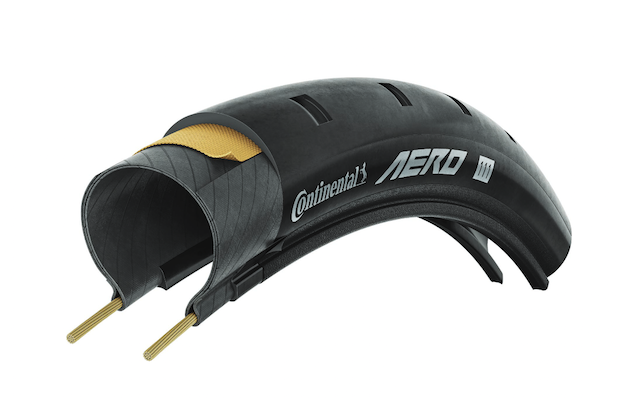
DT Swiss, in partnership with SwissSide and tire manufacturer Continental, have announced a new set of tires called the Continental Aero 111. DT Swiss have been working on this for about 10 years in collaboration with SwissSide. Continental was a logical partner to bring this product to market. In a recent product briefing they referred to this breakthrough as the “first aero tires ever.” Spotted on Decathlon AG2R’s bikes at the Tour de France, the tire will be available at select retailers as early as today in two sizes: 26mm and 29mm. Pricing is nearly 30-40% more than Continental’s other race tire offerings, coming in at $120.95 USD.
An important note is that the tire is intended for the front wheel only. You can put one on the back but will not yield the same benefits. This tire can be installed on any wheel since the improvements are not specifically for DT Swiss wheelsets. However, DT Swiss wheelsets and this tire have been designed together as a system. DT Swiss has options to bundle the tire when ordering their wheels.
The messaging delivered during the briefing was that it’s all about aero. Many of us think aero only applies to people riding 45km/h (28 MPH) and greater. There are properties of this wheel that make it attractive to amateurs and pros, at a range of speed as low as 30km/h (19MPH).
We will go into the benefits of these new tires. We will compare them to what is believed to be the current fastest tire, the Vittoria Corsa Pro Speed. At the time of publication, we have not yet been able to put our hands on the product, but samples should be arriving soon. In a later article, we will do an analysis with the numbers provided by DT Swiss and other sources of tire performance data. I believe that many of these claims can be tested in real world conditions.
Rolling Resistance
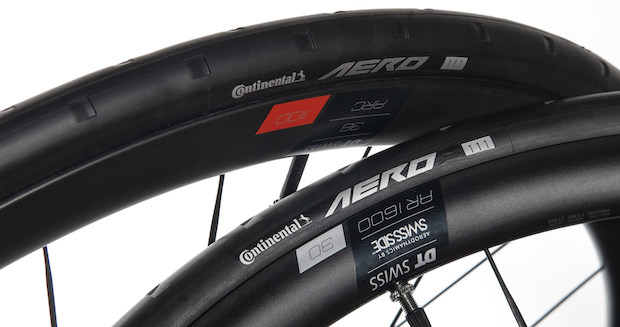
When discussing tire performance we tend to talk most often about rolling resistance. Sites such as Bicycle Rolling Resistance provide data on a coefficient of rolling resistance (CRR) and we can easily figure out how many watts faster one tire rolls than another. BRR data is not perfect but a good data point around which to have a conversation on performance. The recently released Vittoria Corsa Pro speed is at the top of the list. The Continental 5000 TT TR is also a top 10 contender and the GP 5000s TR sneaks in at #12.
We chose to use the Vittoria as a comparison because it’s #1. The two other Conti are used because the announcement provides no rolling resistance data but does say things such as “expect it to be between this tire and that tire” on several fronts.
At 36km/h (22.5MPH), the Vittoria will require 19 watts to roll, compared to 23w for GP5000TT and 26w for the 5000s. A 7 watt spread is considerable.

The Aero 111 tires share technology with other Conti tires, so their performance is predictable. Conti claims the rolling resistance for the tires is between that of the 5000TT and 5000S. The Aero 111 tire uses the same Black Chili compound known for its grip and rolling resistance.
If we average the two tires and compare them to the Vittoria at various speeds, we see the Corsa Pro speed still has about a 5w advantage in terms of rolling resistance.

Durability and puncture resistance are very closely related to rolling resistance. Manufacturers may choose to put less protection or make thinner tires to improve rolling resistance. BRR scores puncture resistance and gives a score of 34 for the 5000s, 33 for the 5000TT and 25 for the Vittoria. Higher is better but how this translates to the real world is difficult to assess. Continental claims the new tire should be on par with the most durable 5000s. It is based on the same Vectran technology that is both light and does not impact rolling resistance.
Aerodynamics and Performance
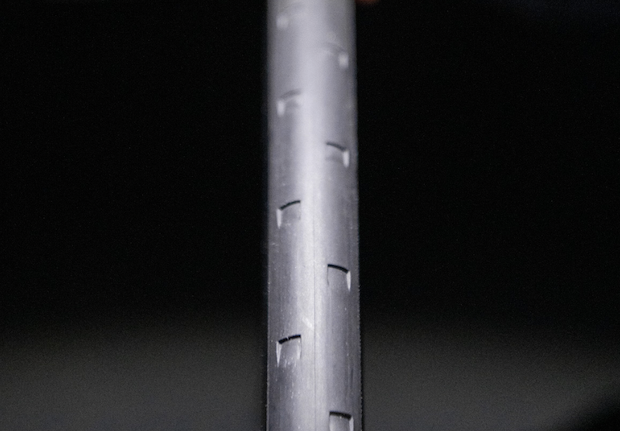
There have been great discussions in the forum, with the likes of Xavier Disley sharing his opinion on the trade-offs between faster rolling tires and making it through an Ironman bike leg without a flat. But 5 watts is considerable. What if the performance gap could be closed while keeping the superior puncture resistance ? Can aerodynamics close this gap? We rarely talk about the aerodynamic differences between two tires. The width of the tire and its dimensions relative to the rim are known to be a factor, but rarely have we seen data saying, “this tire in a 28 is more aero than that tire in a 28.”
This time around, it’s the biggest component of the announcement. We are also conditioned to think that aero gains are especially important when traveling at pro speeds like 45km/h (28MPH). With this announcement there are claims of substantial aero savings at speeds as low as 30km/h (19PMH).
Jean-Paul Ballard of SwissSide explained the theory of this aerodynamic advancement. Basically, if you can cause turbulence at the rim, air will “stick” to the rim and generate less drag. If you look at the tire you will see patterns that appear chiseled into the tire and these little features are referred to as “vortex generators”. They experimented with the size of these features and their positioning, depth and came to a solution they claim is just right. These features condition the airflow to achieve the desired effect.
You can’t discuss aero without consideration of yaw. Yaw is the angle at which the wind is hitting the rim/tire. 0 Yaw is head on, negative is coming from the drive side and positive from the non-drive side. The effective yaw angle will depend on the direction of travel, your speed as well the direction and strength of the wind. The faster you are going, the smaller the apparent yaw angle will be. There is a common belief that at the speed World Tour riders go, the yaw angles are very small. The reality after testing in Arizona on days with brutal cross winds, even pros see yaw. If you connect and analyze data from Kona, you will quickly see yaw is real and needs to be considered.
A great primer for the conversation is this 2016 Slowtwitch article which explains how various parties tried to assess yaw.
How you weigh the probability of seeing various yaw angles will determine how much these tires stand out. The manufacturer claims that from 0 to 10 degrees (and 0 to -10), these tires perform in a very similar way to the 5000TT or 5000s. However, at 10 degrees and beyond is where the magic occurs. Several of the sources discussed in the ST article seem to agree that on a course like Kona, a large percentage of time will be spent between -10- and 10-degrees yaw, but somewhere around 28% of the time will be above. (It’s interesting to note the outlier back in 2016 was SwissSide that claimed little time was spent above 10 degrees.)
The media kit provided some charts to help quantify aero savings. They provided data at 30km/h and 45km/h and showed “aero watts” required at various yaw angles from -20 to 20 and compared the Aero 111 and GP5000s. The two tires track very closely from -10 to 10 yaw. Beyond those points, they diverge, the Aero 111 needing less aero watts.
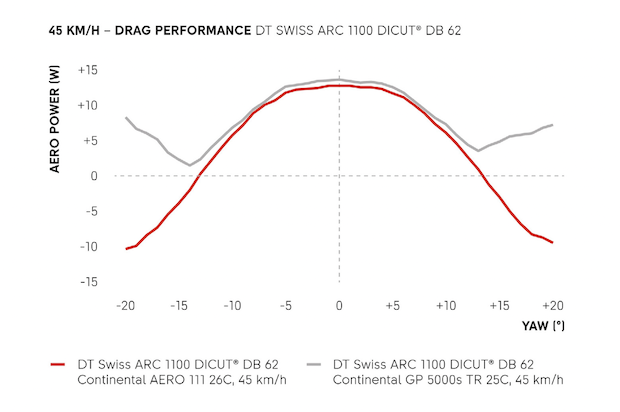
At 45km/h, the new tire will “sail,” providing thrust – at least, on the DT Swiss wheel. They also provided data for the wider 29mm tire at 30km/h. And there were some comparisons to other tires. Unfortunately, the Corsa Pro Speed was not one of them. At 30km/h (19MPH) at 20 deg yaw, there is approximately a 4 watt aero benefit, which is considerable at such a slow speed. At 45km/h (28mph) that turns into a whopping 17 watts gain at 20 deg yaw. To note, these numbers are visually interpolated from the charts provided.
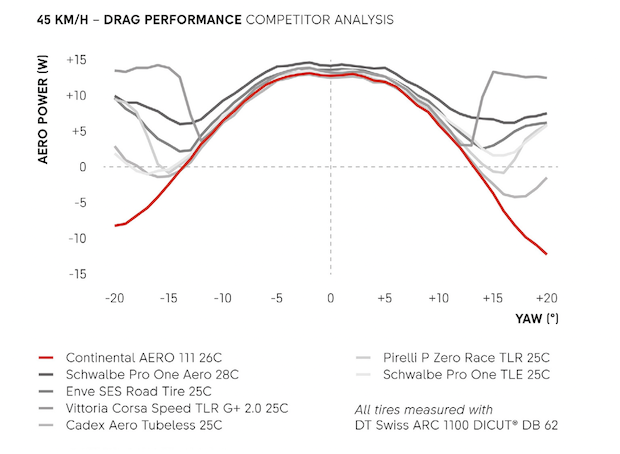
So how much would you tend to save in a typical Ironman? That is very course dependant. But we go back the 2016 article, one source claims about 28% of the time. If we take the data provided by DT Swiss and apply a distribution of yaw angles reported in that article, we will see an average savings somewhere around 3 watts. We have closed part of the 5-watt rolling resistance gap. At slower speeds, such as the 30km/h speed, the savings in watts are less, but the probability of seeing 10-20 degrees of yaw is much greater, therefore the probability of getting full benefit is greater. When we do road tests, we will try to quantify this.
An important consideration that is difficult to put a watt count on is how these tires impact handling. Jean-Paul Ballard explained that in cases of cross wind, the force we feel that results in the difficulty controlling the wheel, is in fact the air detaching and re-attaching to the rim. These new tires, by keeping the air attached to the wheel, should result in a much smoother control, allowing us to possibly handle deeper section wheels and never having to come out of aero to do so. The claim is that you “just feel this” while riding the tires. We can do better than that: it’s something we will be able to measure on the road with a gyroscope measuring around the steering column.
A question that came up in the briefing was how tire wear impacts the aero benefit. The reply was that Decathlon/AG2R has been riding these tires for a while, and that they brought tires 2/3 worn back to the wind tunnel and saw no degradation of aero performance. They quoted that 2/3 point to be about 2500 km / 1550 miles.
Lastly, the tires work with both hooked and hookless wheel systems. They said hookless provided no additional aero benefit and the hookless testing is done entirely by Continental.
Conclusion
I have thrown a bunch of watts at you and the bottom line is how much quicker will these tires get me to the finish line and will I puncture getting there. Well, like everything thing aero, “it depends.”
First, we must see how all these numbers play out in the real world. BRR numbers are great, but they are not on real asphalt. Second, we need to see how manufacturer aero claims from the wind tunnel pan out on the road. And finally, we need to test these claims in real world wind conditions. Since starting to measure yaw on the open road, I have seen numbers higher than I was previously led to believe.
Do we have a new #1 in tire performance? Hopefully we will get a chance to confirm some of those things in the real world.
You can find the ongoing discussion about this new tire in our Reader Forum here.
Photos, Charts Courtesy of Continental / DT Swiss / SwissSide


Start the discussion at slowtwitch.northend.network